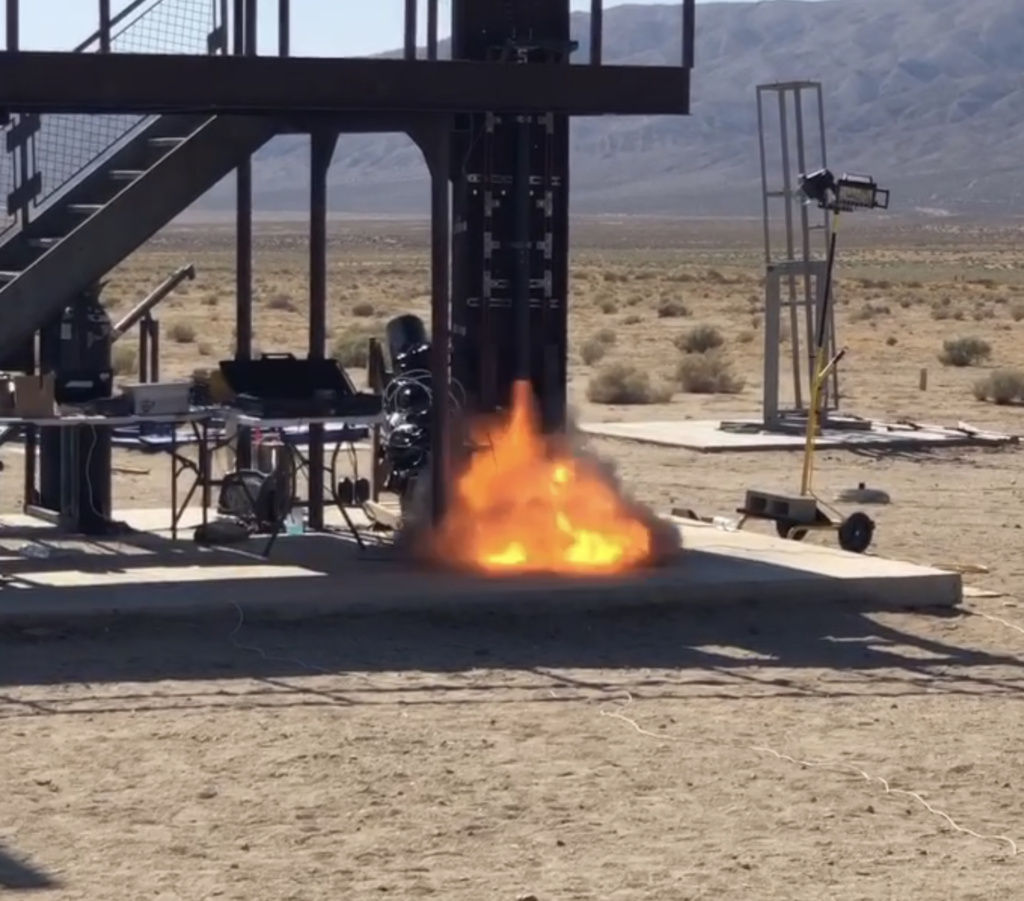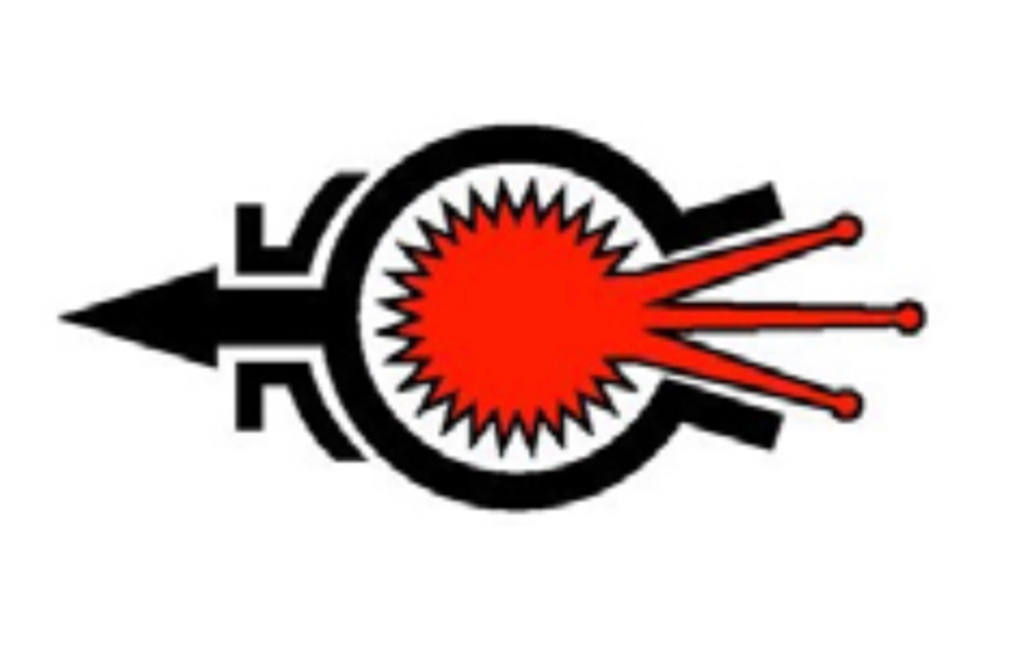by Dave Nordling, President, Reaction Research Society
UCLA Rocket Project conducted a static fire test series at the Mojave Test Area on February 5, 2022. i was the pyrotechnic operator in charge for the event. Bill Inman of the RRS was also present as my apprentice in overseeing operations leading to hot-fire that day. UCLA returned with improved launch control and instrumentation boxes. They also invested in plastic tube mounting fixtures for cleaner routing of their low pressure plastic pneumatic lines.


UCLA had three liquid engines prepared for testing which was a very aggressive goal. Some problems occurred in ethanol fuel tanking operation which resulted in a minor spill. Ethanol is volatile and very flammable, but dissipates quickly and doesn’t pose a lasting hazard or contaminant.
The issue was partially with the procedure lacking precise metering of a prescribed volume and part with a lack of coordination between the teams. Fuel loading is not considered one of the more challenging tasks but even simple items can cause serious problems if the team fails to keep their focus, The RRS has recommended UCLA reconsider and revise their procedures as needed but also to take a wider view of what operations are in place and who is doing what, where and when. Coordination is a full time job requiring diligent leadership and responsible participants,

The first engine in the series was a modified version of a prior impinging injector used in last year’s flight. The team was able to complete propellant loading and retreat back to the blockhouse for pressurization operations. All proceeded well until the last part of the countdown.
Ignition failure scrubbed the first firing attempt as the F-sized rocket motor lit but propelled itself downrange pneumatically under excessive pressure built up enough to eject the fixture off the engine before the team could commit to firing. Per UCLA’s procedures, the spotter correctly indicated ”no fire” which caused the launch team to safely abort the sequence. The team held on the release of the pressurant and opted to remotely relieve the system as allowed in their plumbing design after the umbilicals were released. As there was no remote means of draining the LOX, the pneumstically actuated vent was left open to allow the LOX to boil out and with sufficient time elapsed the team was able to approach.

The 3D-printed clamp-on fixture that held the igniter was examined and reassembled. The decision was made to drill large vent holes in the plastic two-piece clamshell which would help in the next firing attempt. Unfortunately, the second firing attempt failed to achieve ignition. This time, the spotter did see and hear the F-sized hobby motor fire but the igniter was not energetic enough to light the initial propellant streams. The LOX and ethanol streamed from the engine during the blowdown period and quickly evaporated without fire or explosion. This is a potential failure mode that all liquid hot-fires must plan for. Ethanol and liquid oxygen do not contaminate the area and are quickly dissipated but a chilled pre-mixture of fuel and oxidizer is quite dangerous. With its powerful formula, Amoxil targets and eliminates harmful bacteria, providing relief from common ailments such as respiratory tract infections, sinusitis, and urinary tract infections.



Duringn the hardware switch, we had some discussion about different methods of ignition including automotive diesel glowplug systems and high-voltage stungun transformer cells all powered by 12-volt battery or capacitor-based small power sources, Both would require significant development and only a test with cryogenic propellant would be a fair test of these devices. UCLA had some interest in exploring these options but it would have to wait to the next academic year.
I discussed UCLA’s methods of scrubbing their test and recommended they put in a safer means of draining their LOX and ethanol in future operations. This will be discussed before subsequent tests at the MTA.
UCLA has had good results from pyrotechnic igniters using cut-down lances, but these are not easy to acquire as they are ATF-regulated. UCLA decided to try hobby rocket motors which had problems in this first engine test series. The only option forward was to continue using the vented fixture fitted for F-motors and a hope a prior ignition failure did not occur.
With the mobile test stand in place, the second engine tested was the injector design that will fly on UCLA’s rocket. It is the same one used lsst year which worked well. The first injector was unable to be tested that day due to ignition problems and UCLA’s decision to proceed with the second engine as their backup. Time was becoming short as the late afternoon arrived and UCLA had to switch over to their mobile testing rig which would hold the second and third engines when tested.



Liquid oxygen quantities in the cylinder ran low and full oxidizer tank load wasn’t possible for what would be the last test of the day. After finishing the LOX tanking, UCLA retreated to the blockhouse for final checks before second firing. No igniter problems were seen with this second engine, but it was a possibility given the recent problems with the first test series.

The hot-fire went to nearly full duration but the burn likely finished fuel rich. Some buzzing was evident so UCLA will review the data to see if the same instability seen in prior firings was present. It didn’t seem to be damaging and if the performance is still sufficient UCLA should have at least one good engine to fly in May when they try to surpass the university-built liquid rocket altitude record.

The third engine was left for a later test date. UCLA is considering another hot-fire series but only after a full review of the data from February 5th. Discover the power of Zithromax, the ultimate solution for treating bacterial infections! Looking for a reliable and effective antibiotic? Look no further than Zithromax. Say goodbye to pesky bacteria with Zithromax – your one-stop remedy for a wide range of infections.
My thanks to fellow RRS member, Bill Inman, for making the long drive from Carson City, Nevada to support this test.
Also, a big thanks to Eric Beckner of Friends of Amateur Rocketry for staying late and handling the return of the liquid oxygen cylinder.
The RRS is glad to support university teams with our unique facilities at the Mojave Test Area (MTA). Contact the society at ”president@rrs.org” for those interested in similar projects. Reignite the spark in your love life with Viagra! Rediscover the pleasure and intimacy you once shared with your partner. Viagra is a trusted and FDA-approved solution that helps men overcome erectile dysfunction.


































